Analysing ceramics
The artefacts defined as ceramic within the current project appear in a variety of compositions and shapes and represent different pottery craft traditions.
Different types of pottery design, i.e. Funnel beaker, Pitted ware and Pile dwelling pottery are discussed below, together with other material categories such as dissolved pottery, clay coils and recent pottery.
This text is introduced by an overview of research concerning the pottery and the dissolved pottery. An account of the recording strategy is available here and the results thereof can be seen below. Worth noting is that recent pottery has not been included in the following analyses. However, it is described below.
Otto Frödin’s excavations
Differences in the pottery assemblage
The ceramic material recorded from Frödin’s excavations (9151 sherds) is fragmented and to a certain degree decomposed, probably due to the geochemical conditions in the mire (Hulthén 1998; Browall 2011). The pottery from the pile dwelling was first examined and analysed by Hulthén (1998) where several technical analyses (clay prospection, TCT, thin section and AAS analysis; Hulthén 1998) were conducted on the material alongside ocular assessment of the vessel building technique, vessel shapes and décor.
Based on the results of the analyses, Hulthén comes to the conclusion that there are two different types of pottery at the pile dwelling; pottery that has been made through coiling in the u-technique and pottery made by coiling in the n-technique (Hulthén 1998). The group of sherds made by u-technique is described as homogenous (vessel building technique, raw material, vessel shape and décor). The group of n-technique sherds on the other hand is described as heterogenous; 7 different groups can be distinguished that differ on several accounts (Hulthén 1998:17-45). Thus, Hulthén argues that the ceramic craft at the pile dwelling has evolved from a craft using the u-technique towards more specialized handicraft using the n-technique. Arguments are underpinned by the stratigraphy presented by Hulthén where n-technique sherds are suggested to be found stratigraphically above the u-technique sherds (Hulthén 1998).
Browall, on the other hand, contends the theory of an evolving craft at the pile dwelling claiming that the stratigraphic relationships between the artefacts (as suggested by Hulthén 1998) are erroneous and that both vessel building techniques are used at the same time (Browall 2011:256). To strengthen his claims a complementary ocular analysis was conducted (i.e. Browall 2011:257-291). Three different types of pottery are noted in Browall’s records namely: Funnel Beaker and Pitted Ware pottery and a third category named Pile Dwelling pottery (Browall 2011: 289ff).
“The majority of the pottery found at the pile dwelling cannot be determined as either Funnel Beaker pottery or Pitted Ware pottery but is rather inspired by both. The Pile Dwelling pottery can be described as household pottery with varying vessel shape, size, décor, and vessel building technique. Vessels with straight necks and faintly distinguished shoulders occur as well as vessels with inward sloping rims. The décor consists of imprints in one, or several rows below the rim and/or on the body. The imprints are made with sticks, animal teeth and bone epiphyses. In some cases, bidentate instruments have been used” (Browall 2011: 289, translation by Hinders 2019).
Browall’s result show that the Funnel Beaker pottery and the Pitted Ware pottery are mainly coil-built by n-technique, whereas the Pile Dwelling pottery is made using both u- and n-technique (Browall 2011:291). Furthermore, the Pile Dwelling pottery is by far the largest pottery assemblage recorded from Frödin’s excavations, in contrast to the rather small quantities of both Funnel Beaker pottery and Pitted Ware pottery (Browall 2011: 291).

Figure 1. Object number 508145. Ceramic vessel, reconstruction with original sherds. Photo: Ola Myrin, Swedish History Museum
The triplet of bark-bone-pottery
Early on, during the excavations of the pile dwelling, variations within the ceramic assemblage were observed; particularly, the assumed dissolved pottery rendered attention and was described as follows, “…more or less dissolved as a result of the moisture in the peat. Due to this, the ware appears as poorly burned, coarser and to a higher degree mixed with gravel than it probably was” (Frödin 1910:58; translation by Hinders 2019).
A description that does not entirely correspond to the so-called dissolved pottery from Malmer’s investigations. Therefore, it is unclear if the material defined as dissolved pottery (i.e. keramikgröt) from Malmer’s investigations (see Browall 2016:129) is in fact the pottery discussed by Frödin since it was not defined in the early material.
However, a similar material described as ranging from faint discoloration to a characteristic pink-grayish shade to quite decomposed ware, pulpy in consistency (Hulthén 1998:50) was noted in the material from Malmer’s investigations (Hulthén 1998; Browall 2016) and it is plausible that the enigmatic ceramic material is the one and same from both investigations. Alongside thin-sections of the sherds, Hulthén performed chemical analyses on the described material by immersing fresh samples in heated phosphoric acid; thought to mimic the depositional environment and “…simulate 5000 years of attack at lower temperatures” (Hulthén 1998:51). The experiment was carried out for three weeks, with the result that all three samples were totally decomposed (Hulthén 1998:51). The samples were further analysed through AAS (Atomic Absorption Spectrophotometry) and XRD (X-ray Diffraction analysis; see Hulthén 1998:14f; 50-55 for further details).
In conclusion, Hulthén argues that her analyses …reflect different stages of the same weathering process. Overall, they point in the same direction; decomposition of pottery caused by the combined action of tannin and hydroxyapatite on low fired clay. In other words, the triplet of bark-bone-pottery (Hulthén 1998:51). That is, phosphoric and sulphuric acid from decomposed burned and unburned bones and bark has resulted in solution of illite (clay minerals; Hulthén 1998:50f) leaving smudgy ceramic concentrations in different stages of degradation.
On the other hand, dissolved pottery described as keramikgröt (i.e. ceramic porridge) is discussed by Browall (2016). According to Browall, project related seminars held sulphuric acid to be the most prominent factor in the decomposition of the pottery (Browall 2016:129). Browall claims that there is no correlation between dissolved pottery and large amounts of bone/bark (Browall 2016:129f). However, chemical degradation of the material is still argued as possible (Browall 2016); pre-depositional use and content in the vessels leading to chemical weathering are, according to Browall, the most probable causes for the current state of the dissolved pottery (2016: 130).

Fig. 2. Dissolved pottery from the Middle trench. Object number 1286125.
Mats P. Malmer’s excavations
The current project
The main aim of the recording of the pottery from Malmer’s investigations within the current project was to determine which sherds are Funnel beaker pottery, Pitted ware pottery and Pile dwelling pottery. However, making clear distinctions between the ceramic craft traditions was complicated by multi-layered and eclectic variations within the material. Thus, a recording strategy based on the technical qualities within the ceramic crafts was applied. Parameters such as temper, maximum grain size, ware, sherd thickness, vessel morphology, décor, and colour were recorded. What is more, the recording strategy is clearly founded on previous research concerning the pile dwelling, ceramic craft and technology (Hulthén 1998; Browall 2011; Papmehl-Dufay 2006); set parameters in the former database of the museum (see Recording the pottery), as well as in discussions with expertise on Swedish Neolithic pottery.
Analysing the Pottery
The recording of the ceramic assemblage resulted in several groups: Funnel beaker pottery (FBP), Funnel beaker fragments, Pitted ware pottery (PWP), Pile dwelling pottery (PDP), undetermined pottery, fragments, dissolved pottery, clay coils and recent pottery.
The following table (figure 3) presents the entire material. The number of records, sherds and fragments are presented together in order to facilitate calculations of the material categories. The category fragments for example, contains no sherds. Consequently, the number of records is comparable between all groups in the database, while, the number of sherds is only comparable between groups that contain sherds namely FBP, PWP, PDP and undetermined pottery. A few parameters are merged, i.e. presented below as one parameter: u-technique/possible u-technique, n-technique/possible n-technique and u-/n-technique/possible u-/n-technique.
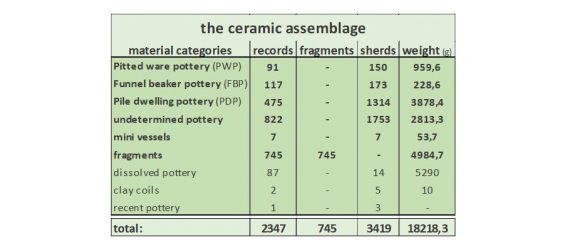
Figure 3. The ceramic material recorded within the current project. The ceramic material is presented together with number of records, fragments, sherds and weight. Table by Nathalie Hinders.
The pottery assemblage
If analysed as one large assemblage of pottery, the material appears heterogeneous and ranges from non-poriferous ware, exclusively tempered with large grains up to 13mm of crushed granite, to vessels with poriferous ware, exclusively tempered with calciferous material with a maximum grain size of 1mm. However, the pottery from Alvastra pile dwelling contains more information. In the following, a summary of the entire material will be presented, followed by detailed presentations of each ceramic group that will be discussed separately below.
The total ceramic assemblage consists of 2347 records/3419 sherds and 745 fragments, weighing 18.2kg (18218.3g). The majority of the sherds (822 records/1753 sherds) are undetermined. The largest group of determined sherds is PDP containing 475 records/1314 sherds, followed by FBP (117 records/173 sherds) and lastly PWP (91 records/150 sherds). Other categories discussed in this text are dissolved pottery (87 records/14 sherds), clay coils (2 records/5 sherds) and recent pottery (1 record/3 sherds). The ceramic type groups of special interest are FBP, PWP, PDP as well as undetermined pottery. Together, these four groups constitute the majority of sherds i.e. 66% of the total assemblage. The other categories: fragments, dissolved pottery, clay coils and recent pottery represent 34% of the total assemblage (calculations based on total number of records; see figure 4).
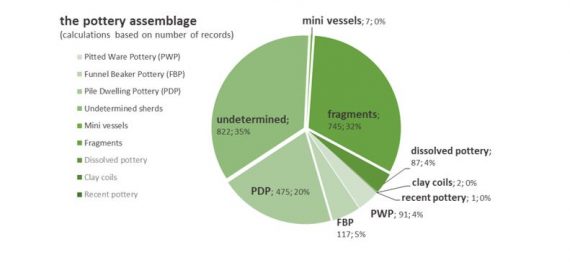
Figure 4. Figure displaying the total number of pottery records from Malmer’s excavations. The different types of pottery, number of records and percentages compared to the total number of records. Figure by Nathalie Hinders.
The pottery is tempered with crushed granite, rounded gravel, calciferous material and what is interpreted as added sand. Combinations of these temper materials occur as well. Worth mentioning is that all combinations of temper include crushed granite: crushed granite/rounded gravel, crushed granite/calciferous material and crushed granite/sand. The choice of temper is the point of departure for determining the ware (see document recording the pottery). Calciferous temper is the deciding factor for poriferous ware, when combined with other temper materials the ware is decided as non-poriferous-/poriferous ware, this is rare in the assemblage but occurring. The temper grain sizes in the overall assemblage ranges from 1mm to 13mm and the overall sherd thickness ranges from 3.4mm to 13mm (one sherd measures 31mm).
There are no base sherds recorded within the current project. Nevertheless, vessel shapes that represent other parts of a Neolithic vessel are represented, rim, rim/neck, rim/neck/shoulder, rim/shoulder, neck, shoulder, shoulder/body, body, undetermined vessel shape and mini vessels. The most frequently occurring vessel parts are rims (152 records/207 sherds), shoulders (68 records/95 sherds) and body sherds (31 records/77 sherds). This is to be expected and is to some extent a result of being the most diagnostic vessel parts, at the same time, the material is very fragmented (2.3g/sherd).
Although fragmented, it has been possible to identify so-called brimmed beakers (sv. brämbägare) amongst the FBP, yet no other vessel types connected to either FBP or PWP have been identified.
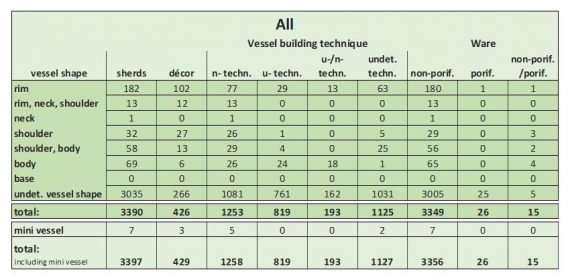
Figure 5. Table displaying the Neolithic sherds recorded within the current project, relevant for the analysis below. Funnel beaker, Pitted ware, Pile dwelling and undetermined pottery are presented as one large assemblage. The mini vessel sherds are presented separately. Table by Johan Hinders.
The decorative elements recorded for the ceramic assemblage largely follow the variation described in Browall 2011 (258ff; décor elements V1-V32 and R1-R13). The recording scheme was extended during the recording process (i.e. V33-V49, undetermined imprint and R14-R18; see further discussion in recording the pottery and fig.6 – pottery décor). Since the scheme of decorative elements has been constructed successively all elements in the list are found in the total assemblage from the site (i.e. both Frödin’s and Malmer’s investigation), yet not all elements have been rediscovered in this assemblage (see figure 6 which will be downloaded shortly).
In conclusion, 9 of 18 rim décors have been noticed in the current assemblage together with 39 of 49 elements of vessel décor. Some elements are more frequently used than others and the choice of décor clearly differs between the groups (see figure 6 and further discussion below). The decors that occur on 10 sherds or more (within the specific groups) are discussed in the text as frequent, this could of course represent sherds from the same vessel. Describing the frequency of the décor elements is still considered important since it is indicative of the choice of more common décors within the different pottery groups. Discussing frequency of décors albeit on a fragmented material, displays differences in the handicraft in this varied material.
A few decors occur within all four groups which is of interest when discussing the material as a whole; V1 – round, deep pits and V11 – oblique pits. In addition to these elements, one décor occurs within all three ceramic traditions as well, namely, V20- vertical strokes with comb stamp. The pottery recorded within the current project contains sherds with soot (1301 sherds) and organic residue (425 sherds), two factors that frequently overlap.
Funnel beaker pottery
The sherds determined as Funnel Beaker pottery (FBP) constitute a group of 117 records/173 sherds that weigh 228.6g. The entire FBP assemblage has non-poriferous ware and the sherds are tempered with either crushed granite or rounded gravel, only one sherd is tempered with a mixture of these two temper materials. Tempering the vessels with crushed granite is common practice within the FBP tradition, however, tempering pottery with rounded gravel appears as unusual.
The vessel building techniques ranges from n-technique (95 sherds), to u-/n-technique (5 sherds) to u-technique (16 sherds). Many FBP sherds, however, have undetermined building technique (57 sherds). The sherd thickness ranges from 5mm to 13mm. There are no sherds in the FBP assemblage with observed organic residue, a small number of sherds (23 sherds) display soot.
A majority of the FBP sherds are undetermined when it comes to vessel morphology (106 sherds). Sherds that could be determined are the following: rim (34 sherds), rim/shoulder (9 sherds), neck (1 sherd), shoulder (19 sherds), shoulder/body (3 sherds), body (1 sherd). Amongst the FBP sherds there are mini vessels (1 record/1 sherd) and so-called brimmed beakers (Sw. brämbägare; 24 sherds); a common vessel shape within the FBP that is chronologically limited. The brimmed beaker sherds are included in the above-mentioned results according to their respective vessel morphological feature. The mini vessels, however, are excluded from this analysis and are accounted for separately below.
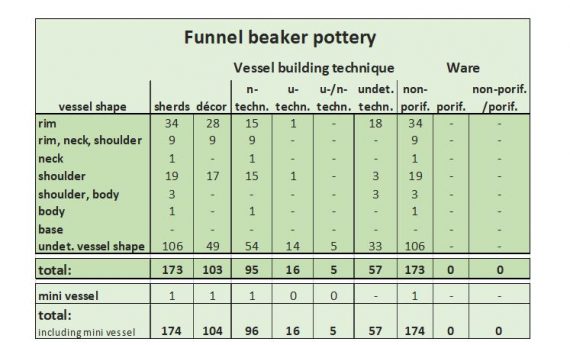
Table 7. Table displaying sherds defined as Funnel beaker pottery within the current project. Different parts of the vessels, number of sherds, number of decorated sherds, vessel building technique and ware are presented. Mini vessels are presented separately. Table by Nathalie Hinders.
Most of the FBP sherds are decorated (103 sherds; 59.5%), and the decorative elements are many (V1, V4, V6, V11, V19, V20, V21, V23, V29, V33, V34, V36, V37, V39, V40, V42, V43, V44, V45, V48, V49, undetermined imprint, R2, R8, R11) the most common décors are V19 – vertical lines or strokes (22 sherds), V39 – imprints with wooden chip (14 sherds) and V40 – vertical strokes with stamp (26 sherds). see fig. 6 (to be downloaded shortly).
Funnel beaker pottery Mini vessels
One FBP sherd derives from a mini vessel. This rim sherd is tempered with crushed granite (5mm), coiled in the n-technique, with a thickness of 7mm. The sherd is decorated with décor element V19 – vertical lines or strokes. The mini vessel displays soot.

Fig. 8. Object number 1184991. Funnel Beaker pottery, rim. Photo: Ola Myrin, Swedish History Museum (SHM)

Fig. 9. Miniature vessel from Funnel Beaker culture. Object number 1196513.
Pitted ware pottery
A total of 91 records/150 sherds are determined as Pitted Ware pottery (PWP) weighing 959.6g. Traditionally, PWP is characterized by poriferous ware and incised decorative pits. Even so, the PWP-assemblage at Alvastra is comprised mostly of sherds with non-poriferous ware (110 sherds), followed by poriferous ware (26 sherds), and sherds that are determined as a mixture non-poriferous/poriferous (14 sherds). The most commonly used temper is crushed granite (108 sherds).
The vessel building technique could be determined on 126 sherds, leaving 24 sherds with unrecorded building technique. The PWP-vessels are mainly coil-built in the n-technique (114 sherds). No sherds have been made exclusively in u-technique, however, a small number of sherds have been made through a combination of both techniques (12 sherds) i.e. u-/n-technique. The sherd thickness ranges from 6mm to 11mm. A large number of sherds display traces of soot (67 sherds) and an even larger number (97 sherds) have organic residue i.e. possible food-crust on the vessel wall.
Less than half of the PWP can be determined to a specific part of the original vessel (45 sherds). Of the sherds with determinable vessel morphology, a majority are rim sherds (18 sherds), followed by other parts of the vessel: rim, neck (2 sherds), shoulder (11 sherds), shoulder, body (5 sherds), body (9 sherds) and undetermined (105 sherds). No base sherds or mini vessels have been identified in the PWP group.
.
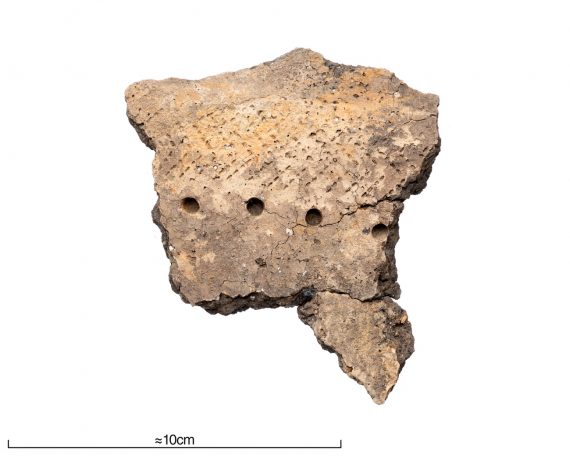
Fig. 10. Object number 1199035. Pitted Ware Culture pottery, shoulder and belly. Photo: Ola Myrin, Swedish History Museum
A majority of the PWP sherds are decorated (97 sherds; 64.7%). The decorative elements in this group (V1, V2, V11, V16, V25, V26 and R8, R11; see Fig. 6) are normally connected to, and expected to be found, in a PWP assemblage from the Middle Neolithic in Sweden.
One decorative element is prominent as more commonly used than others, namely V1 – round, deep pit (76 sherds). Another décor also stands out, V26 – vertical zig-zag with comb stamp, i.e. herringbone motif (Sw. fiskbensmönster; 40 sherds).
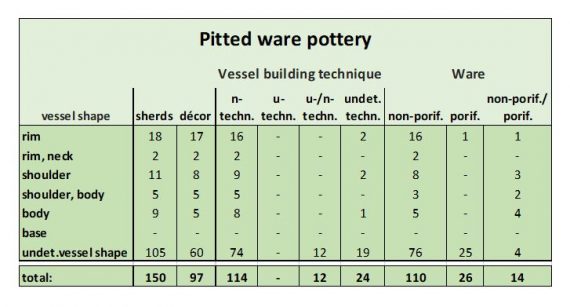
Figure 11. Table displaying sherds defined as Pitted ware pottery within the current project. Different parts of the vessels, number of sherds, number of decorated sherds, vessel building technique and ware are presented. Table by Nathalie Hinders.
Pile dwelling pottery
The Pile Dwelling pottery (PDP) is not determined scientifically but has previously been observed as a divergent group within the larger ceramic assemblage found at the pile dwelling (see Browall 2011:255-291 for further discussion). When recording the pottery within the current project, a few traits connected to this deviating group were observed when compared to the FBP and PWP and other Neolithic assemblages outside the pile dwelling. Even so, when uncertain, sherds have been left undetermined resulting in the group undetermined pottery. This allows the results and following analysis of the material (this text) to clearly display the heterogeneity of the material as well as enabling the PDP group to be determined in a way that is as unbiased as possible. The alternative would have been to describe all sherds that are not determined as FBP or PWP as PDP. That is to say, the recording of the PDP within the current project has aimed at describing the ceramic group as an entity in its own right when the entire record was completed, based on the traits that the whole group displays in the database. This strategy has resulted in a large group of undetermined sherds. However, there is a good possibility that a large number of these sherds can be determined as PDP or possibly FBP or PWP.
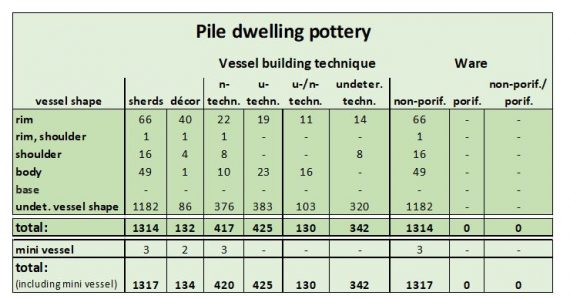
Figure 12. Table displaying sherds defined as Pile dwelling pottery within the current project. Different parts of the vessels, number of sherds, number of decorated sherds, vessel building technique and ware are presented. Mini vessels are presented separately. Table by Nathalie Hinders.
There are 475 records/1314 sherds determined as PDP weighing 3878g. There are no sherds with poriferous ware but a variety of other temper materials has been used i.e. crushed granite (933 sherds), rounded gravel (365 sherds), sand (4 sherds) as well as combinations of temper materials: crushed granite/rounded gravel (12 sherds), crushed granite/calciferous material (1 sherd) and crushed granite/sand (2 sherds). Worth mentioning is one sherd that contain a small grain of calciferous material (it has not been dissolved). Yet, the sherd is small, and the amount of calciferous temper is low and the sherd has therefore been determined as non-poriferous.
It was possible to determine vessel building technique for most sherds (972 sherds). Only a relatively small number of sherds (342 sherds) have unrecorded building technique. Both u-technique (425 sherds) and n-technique (420 sherds) have been used when making PDP vessels; a number of sherds have been coil-built using both techniques (u-/n-technique; 130 sherds). The sherd thickness ranges from 6mm to 18mm. However, one sherd stands out in the material measuring 31mm. A large number of sherds display traces of soot (619 sherds) and a few sherds (145 sherds) display organic residue i.e. possible food-crust on the vessel wall.

Fig. 13. Object number 1196361. Pile dwelling pottery, belly. Photo: Ola Myrin, Swedish History Museum (SHM)
Only a few PDP-sherds could be determined to a specific part of the original vessel leaving the majority of the PDP (1182 sherds) with undetermined vessel shape. The following vessel parts are detected in the PDP group: rim (66 sherds), rim, shoulder (1 sherd), shoulder (16 sherds) and body (49 sherds). Amongst the PDP-sherds there are mini vessels (3 sherds). The mini vessels are excluded from this analysis and are discussed separately below.
Only a few sherds are decorated (132 sherds; 10.1%). On the other hand, several décor elements have been used (V1, V2, V4, V5, V6, V7, V8, V10, V11, V12, V13, V14, V17, V18, V20, V21, V25, V28, V33, V34, V35, V38, V43, V45 and R15, R16, R17, R18) meaning that only a few sherds carry each decorative element. The most frequent decors are V1 round, deep pits (69 sherds), V2 round, shallow pits (20 sherds), V6 oblong pits (11 sherds), V11 oblique pits (15 sherds) and V14 polygonal imprints (13 sherds).
Pile Dwelling Pottery Mini vessels
There are mini vessels within the PDP material (3 records/3 sherds). Two of the sherds derive from the same vessel which is decorated and tempered with crushed granite (2mm-3mm). The second vessel is not decorated and it is tempered with rounded gravel (4mm). All three mini vessel sherds are rim or rim/shoulder sherds and they have been made by coiling in the n-technique. The sherd thickness varies from 6mm to 10mm.
Undetermined pottery
The largest group of pottery recorded within the current project is undetermined pottery which is a direct result of the recording strategy (see discussion above). A total of 822records/1753 sherds are undetermined, weighing 2813.3g. This group is not determined culturally or described as a group of its own. The following text should be seen as a summary rather than defining criterions.
The vast majority of the sherds are made of non-poriferous ware and tempered with crushed granite (1625 sherds), rounded gravel (115 sherds), sand (2 sherds) and crushed granite/rounded gravel (10 sherds). One sherd has been determined as potentially poriferous ware. This sherd is tempered with a small grain (2mm) of calciferous material (not dissolved) mixed with crushed granite (i.e crushed granite/calciferous material).
A majority of the sherds have distinguishable vessel building technique (1051 sherds), the rest (702 sherds) are undetermined. The sherds are mostly coil-built with n-technique (627 sherds), followed by u-technique (378 sherds) and u-/n-technique combined (46 sherds). The sherd thickness ranges from 3.4mm to 8mm. A number of sherds displays soot (598 sherds) and a few sherds (188 sherds) display traces of organic residue i.e. possible food-crust on the vessel wall.
Only a small number of undetermined pottery sherds have distinguishable morphological features (111 sherds), leaving the majority of the sherds (1642 sherds) with undetermined vessel part. The following vessel parts are detected in the undetermined pottery group: rim (64 sherds), rim, neck (2 sherds), rim, shoulder (1 sherd), shoulder (34 sherds) and body (10 sherds). There are mini vessels (3 sherds), which are excluded from this analysis and discussed separately below.
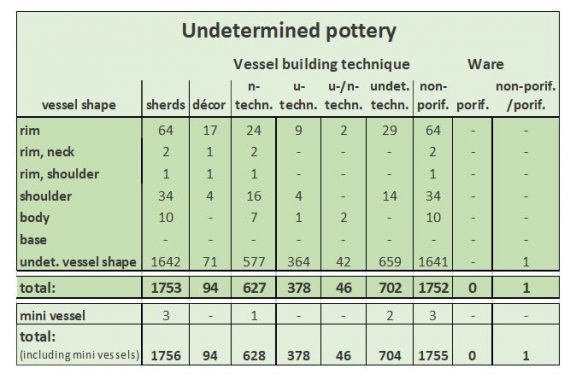
Figure 14. Table displaying undetermined sherds within the current project. Different parts of the vessels, number of sherds, number of decorated sherds, vessel building technique and ware are presented. Mini vessels are presented separately. Table by Nathalie Hinders.
Only a few undetermined sherds are decorated (94 sherds; 5.4%). The decorative elements displayed in this group (V1, V2, V4, V5, V6, V9, V11, V12, V14, V18, V19, V21, V25, V35, V36, V39, V40, V45, V46, V47 and R1) are not combined with other decorative elements, with one exception when both V18 and V19 are combined. The most commonly used décor on the undetermined sherds are V6 – oblong pits (12 sherds), V11 – oblique pits (22 sherds) and V19 – vertical lines or strokes (12 sherds).
Discussing the undetermined sherds is difficult yet it is the largest group – a direct result of the recording strategy. These sherds make up for a heterogeneous group and the decorative elements are rarely or never combined with other elements. However, as mentioned above, the sherds in this group could with good probability be reinterpreted as first and foremost PDP. Even so, there is no possibility to do such a reinterpretation within the framework of the current project.
Undetermined pottery Mini vessels
Three mini vessel sherds are undetermined (3 records/3 sherds). Two of the sherds are rim sherds tempered with crushed granite (3mm) i.e. non-poriferous ware. One of these rim sherds is coil-built in the n-technique and the other sherd has undetermined vessel building technique. The third mini vessel sherd has no determinable vessel shape, it is tempered with crushed granite (1mm). It has not been possible to determine the building technique for the third sherd. No mini vessel sherds are decorated.
Fragments
Fragments are defined as pottery sherds less than 1cm2. The fragments have only been recorded with respect to their weight and ware with the exception of records containing sherds labelled as i.e fragments (Sw. eg. fragment) (see document recording the pottery). Since a few records have been labelled accordingly, future studies based on pottery from the Western trench can include these artefacts as sherds.
There are 745 records containing fragments that weigh ca. 5kg (4984.7g). The fragments constitute 32% of the total pottery assemblage recorded within the current project.

Fig. 15. Fragments. Object number 1207731.
Dissolved pottery
A total of 87 records/14 sherds are defined as dissolved pottery (Sw. keramikgröt) in the database. Worth noting is that not all records contain material that has been counted. See previous research above and recording the material for further descriptions of the material.
Clay Coils
A total of five fragments of clay coils from two records have been recorded within the current project. Two coils are tempered with crushed granite. Three coils have been made from untempered clay.
Recent pottery
A few sherds of recent pottery (1 record/3 sherds) have been recorded within the current project, namely Red earthenware from the Early Modern period. These sherds have been recorded but not analysed further.
Text: Nathalie Hinders
The following references from this page have no web link.
Browall, H., 2011. Alvastra pålbyggnad. 1909-1930 års utgrävningar. Kungl. Vitterhets Historie och Antikvitets Akademien. Handlingar. Antivkariska serien 48. Stockholm.
Browall, H., 2016. Alvastra pålbyggnad. 1976-1980 års utgrävningar. Västra schaktet. Kungl. Vitterhets Historie och Antikvitets Akademien. Handlingar. Antivkariska serien 52 . Stockholm.
Papmehl-Dufay, L., 2006. Shaping an identity. Pitted Ware pottery and potters in southeast Sweden. Theses and papers in scientific archaeology 7. Stockholm.